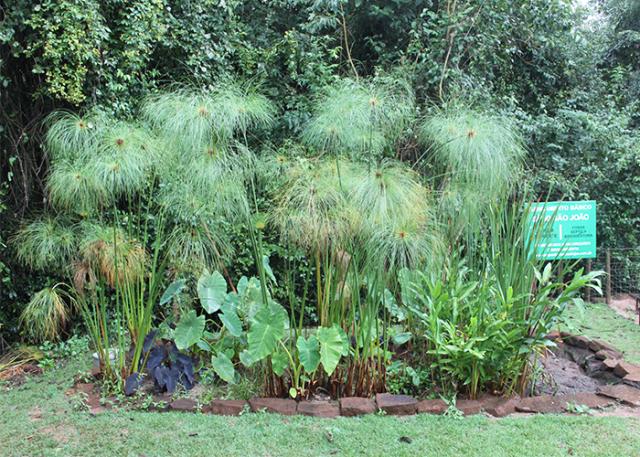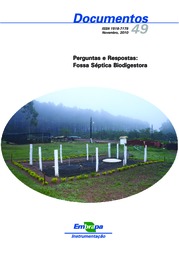Rural domestic sewage becomes organic fertilizer
03/03/15
|
Environmental and land management
Rural domestic sewage becomes organic fertilizer
In rural areas, it is common to find a simple hole, dug next to the main house, where domestic waste is deposited, which is known as a cesspit. Over time, the waste disappears, leading users to believe that the system is clean and safe. Far from it: the residue does not disappear; it seeps into deeper layers, contaminating the soil and the groundwater. By using the water from nearby wells, the resident family can get sick.
The story above is told by the researcher Wilson Tadeu Lopes da Silva, from Embrapa Instrumentation, and illustrates the distressing reality of most families who live in the countryside. "The domestic sewage thrown into cesspits or streams is a serious problem that directly affects water quality", Silva asserts. Upon consideration on the issue, the researcher developed a way to bring basic sanitation to rural areas and also transform domestic sewage into organic fertilizer. The solution was to develop a treatment that supplements basic sanitation in rural zones. It comprises a set of technologies named as Filter Garden, which includes the Biodigester Septic Tank and the Embrapa Chlorinator.
As the septic tank only treats human sewage, the filter garden became an alternative to provide a suitable destination for residential graywater, composed of effluents from sinks, tanks, basins, and showers, and the treated effluent from the septic tank. Despite contaminating less than blackwater, graywater also deserves attention, as it is imbued with soaps and detergents, as well as food remains and fats.
The biodigester septic tank is a system that farmers can make themselves. Domestic sewage is diverted from the toilet bowls, through piping, into fiberglass water tanks that are buried in the ground. For a family of five people, the suggestion is to install three to four fiberglass water tanks. The organic fertilizer generated by the biodigester septic tank should only be applied on the soil, in orchards, or in other plants where the biofertilizer does not come in direct contact with plant parts that are ingested as raw foods.
The Embrapa chlorinator is a complement to the basic rural sanitation system. Farmers can easily assemble it at a low cost with parts found in building supply houses. The Chlorinator is installed between the piping that collects water and the reservoir. To chlorinate the water, a level teaspoon of calcium hypochlorite is added to the chlorine receiver. After 30 minutes, the water is chlorinated, germ-free, and ready to drink.
In August 2014, at the Agrifam Family Farming Fair in Lençóis Paulista, SP, Embrapa signed a contract to transfer Filter Garden know-how to the company Ecosys, which will sell the technology.
"Dia de Campo na TV" presents filter gardens
The first step towards installing a filter garden is to choose the location to dig a ditch that should be ten square meters large. That size is ideal for a family of five. The ditch has to be waterproofed with a high density polyethylene geomembrane or equivalent, preferably protected by bidim liners - a geotextile drainage liner used in civil construction.
Before entering the filter garden, the effluent goes through a tank that retains solids, and another that retains fats. The treated liquid leaves through a pipe-shaped duct that also regulates the garden's water level. The entrance and exit points have to be installed on opposite sides of the tank.
The filter garden's site has to be pre-filled with crushed stone and coarse sand. Then a small countour line is built around garden, under the geomembrane and the bidim, to prevent leaching into the system. The next-to-last step is to add water.The filter garden has to be saturated with water, but one should avoid the formation of a layer of stillwater, to prevent mosquitoes from breeding.
The filter garden's site has to be pre-filled with crushed stone and coarse sand. Then a small countour line is built around garden, under the geomembrane and the bidim, to prevent leaching into the system. The next-to-last step is to add water.The filter garden has to be saturated with water, but one should avoid the formation of a layer of stillwater, to prevent mosquitoes from breeding.
The final stage is the placement of macrophyte aquatic plants, which will draw nutrients from the water to purify it and provide for a visually pleasant environment. There is a choice of flowers that thrive in water-saturated soils, such as arum and lily-of-the-marsh, and ornaments with stones. The "Dia de Campo na TV" broadcast named "Filter garden - basic sanitation in rural areas" was produced by Embrapa Instrumentation (São Carlos, SP) and by Embrapa Technological Information (Brasília,DF), units of the Brazilian Agricultural Research Corporation, under the Brazilian Ministry of Agriculture, Livestock, and Food Supply.
Published in the XXI Science for Life magazine
Translation
Mariana de Lima Medeiros
Mariana de Lima Medeiros
Joana Silva (MTb 19554/SP)
Embrapa Instrumentation
Press inquiries
instrumentacao.imprensa@embrapa.br
Phone number: (16) 2107 2901
Further information on the topic
Citizen Attention Service (SAC)
www.embrapa.br/contact-us/sac/


